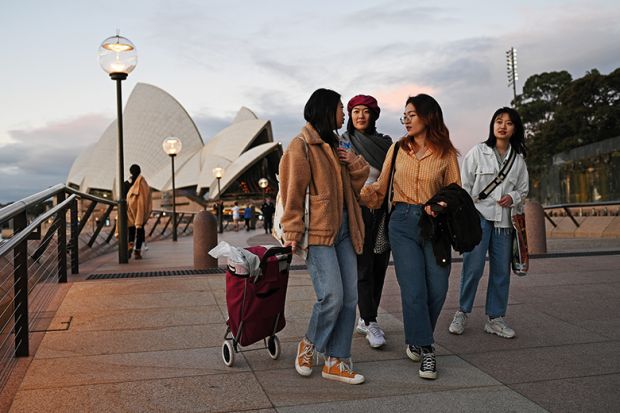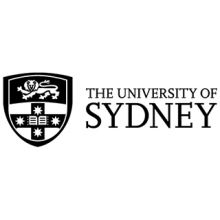Experts are unsure whether Chinese authorities’ pressure on local education agents to steer their clients away from Australia, in the wake of Beijing’s claims about Australian safety risks and low-quality educational partnerships, will undermine student flows Down Under. But if it does, the financial effects could exceed and outlast the damage from Covid-19.
While the pandemic cost universities an estimated A$3 billion (£1.7 billion) in 2020, that toll would be overshadowed by the loss of Chinese students. A Times Higher Education analysis has found that they contributed at least A$4.2 billion to university revenue in the pre-Covid peak year of 2019.
More than 80 per cent of this windfall went to 10 universities that drew at least 10 per cent of their revenue from Chinese students. Each amassed nine-figure sums from this source, led by the University of Sydney with more than three-quarters of a billion dollars.
These figures are based on average international tuition fees at each university, and are probably underestimates. Chinese students tend to pay premium fees because they attract few discounts and gravitate to expensive business courses.
While a complete withdrawal of Chinese students seems unlikely, experts cautioned against complacency. “The situation is as bad as it has ever been,” said Angela Lehmann, a China specialist and head of research at international education consultancy The Lygon Group.
January’s criticism of joint Chinese-Australian degrees was a “real signal” that universities were now embroiled in a trade war, Dr Lehmann said. While the safety warnings had been directed at parents who had “already made up their minds” about Australia, the criticism of partnerships had raised “a question over Australia’s reputation” to “a new group of fairly powerful people”.
She said there was often speculation that Chinese authorities might take concrete actions to “stop the flow” of students to Australia. “I’m sceptical that they’d say students can’t come to Australia any more. But there are ways that journey could be made more difficult and students could be redirected elsewhere. We’re seeing the beginnings of that.”
James Laurenceson, director of the Australia-China Relations Institute at the University of Technology Sydney (UTS), said that the signals from China were not cause for panic. “Beijing doesn’t get to tell Chinese parents where their kids should be educated,” he said.
“One of the great strengths of the Australia-China relationship is the people-to-people ties. Most families know someone [here] so they can sort of cross-check the Beijing line to see if it stacks up. In the big cities, I don’t know how much weight a few informal comments to education agents would carry. In a smaller city where they’re more connected to the government, that might be a bigger risk.”
University of Sydney political sociologist Salvatore Babones, who highlighted Australian universities’ reliance on China in a 2019 report, said that the latest developments were cause for alarm. “The Chinese consulate has been warning students away from Australia for its supposed racism for several years now, but this seems a more systematic campaign,” he said.
Dr Babones’ report rated political tensions as only a moderate risk to Australian university income. While Beijing had “weaponised tourism” in a 2016 dispute with South Korea, it had not previously disrupted educational ties. But coronavirus could change this, Dr Babones stressed. “They are not warning students in Australia to leave – they are warning students not to go, which is a much easier proposition.”
The loss of Chinese students would be a relatively mild blow to the nine Australian universities that earned less than 2 per cent of their 2019 income from Chinese students, and another 11 institutions with Chinese student revenue of up to 5 per cent.
But it would be devastating in Australia’s biggest city, where three institutions – Sydney, UNSW Sydney and UTS – each obtained more than 20 per cent of their income from Chinese students’ fees.
Share of Chinese students and contribution to revenue in 2019
|
University |
Chinese % of all students |
Estimated % of revenue |
|
University of Sydney |
29.1 |
27.0 |
|
25.6 |
21.7 |
|
|
18.7 |
20.6 |
|
|
23.4 |
18.2 |
|
|
20.5 |
17.4 |
|
|
28.7 |
15.7 |
|
|
19.7 |
14.9 |
|
|
16.5 |
13.6 |
|
|
10.2 |
12.0 |
|
|
12.5 |
10.3 |
Dr Lehmann said that the real risk to Chinese enrolments in Australia was not “top-down pressure” from Beijing. Rather, the rhetoric could intensify families’ doubts about expensive Australian degrees – particularly with about three in five Chinese students now studying remotely from home – and resentment over Canberra’s treatment of overseas students.
“We see stories of international students lining up for food; about international students not being included in our Covid response,” she said. “[These] people have been completely neglected by the federal government. Yet when the Chinese government puts out a slight warning, everyone panics.
“There needs to be a little soul-searching here. If something’s going to slow down the flow of students, it’s the way we’ve managed this situation ourselves.”
POSTSCRIPT:
Print headline: Australia-China situation is ‘as bad as it’s ever been’
Register to continue
Why register?
- Registration is free and only takes a moment
- Once registered, you can read 3 articles a month
- Sign up for our newsletter
Subscribe
Or subscribe for unlimited access to:
- Unlimited access to news, views, insights & reviews
- Digital editions
- Digital access to THE’s university and college rankings analysis
Already registered or a current subscriber? Login












